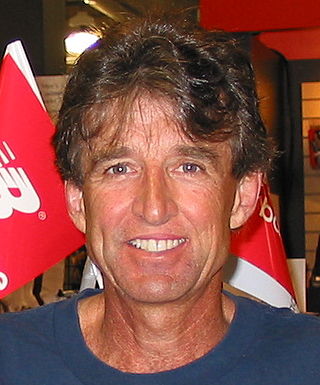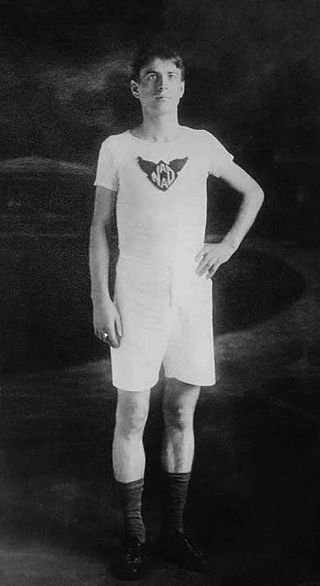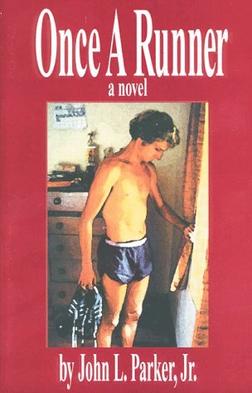
The marathon is a long-distance foot race with a distance of 42.195 km, usually run as a road race, but the distance can be covered on trail routes. The marathon can be completed by running or with a run/walk strategy. There are also wheelchair divisions. More than 800 marathons are held throughout the world each year, with the vast majority of competitors being recreational athletes, as larger marathons can have tens of thousands of participants.

Pheidippides or Philippides (Φιλιππίδης) is the central figure in the story that inspired two modern sporting events, the marathon race and the Spartathlon. Pheidippides is said to have run from Marathon to Athens to deliver news of the victory of the battle of Marathon.

Stephen Henry Jones is a Welsh athlete who set the world record in the marathon in his first completed race at that distance at the Chicago Marathon in 1984, with a time of 2:08:05.

Emil Zátopek was a Czech long-distance runner best known for winning three gold medals at the 1952 Summer Olympics in Helsinki. He won gold in the 5,000 metres and 10,000 metres runs, but his final medal came when he decided at the last minute to compete in the first marathon of his life. He was nicknamed the "Czech Locomotive".

Alberto Salazar is an American former track coach and long-distance runner. Born in Cuba, Salazar immigrated to the United States as a child with his family, living in Connecticut and then in Wayland, Massachusetts, where Salazar competed in track and field in high school. Salazar won the New York City Marathon three times in the early 1980s, and won the 1982 Boston Marathon in a race known as the "Duel in the Sun". He set American track records for 5,000 m and 10,000 m in 1982. Salazar was later the head coach of the Nike Oregon Project. He won the IAAF Coaching Achievement Award in 2013.

Shambel Abebe Bikila was an Ethiopian marathon runner who was a back-to-back Olympic marathon champion. He was the first Ethiopian Olympic gold medalist, winning his and Africa's first gold medal at the 1960 Summer Olympics in Rome while running barefoot. At the 1964 Tokyo Olympics, he won his second gold medal, making him the first athlete to successfully defend an Olympic marathon title. In both victories, he ran in world record time.

Frank Charles Shorter is an American former long-distance runner who won the gold medal in the marathon at the 1972 Summer Olympics and the silver medal at the 1976 Summer Olympics. His Olympic success, along with the achievements of other American runners, is credited with igniting the running boom in the United States during the 1970s.

Clarence Harrison DeMar was a U.S. marathoner, winner of seven Boston Marathons, and Bronze medalist at the 1924 Paris Olympics. He was known by the nickname "Mr. DeMarathon."

Once a Runner is a novel by American author John L. Parker Jr. and was first published in 1978 by Cedarwinds (0915297019). In Once a Runner, Parker illustrates the hard work and dedication required of an elite runner. A reissue was released in 2009. The novel was followed by the sequel Again to Carthage in 2008 and the prequel Racing the Rain in 2015.

Ryan Hall is a retired American long-distance runner who holds the U.S. record in the half marathon. With his half marathon record time (59:43), he became the first U.S. runner to break the one-hour barrier in the event. He is also the only American to run a sub-2:05 marathon. However, this time is not eligible to be a record due to the course being point-to-point and a net-downhill course. Hall won the marathon at the 2008 United States Olympic trials and placed tenth in the Olympic marathon in Beijing.
Ellison Myers Brown, widely known as Tarzan Brown, a direct descendant of the last acknowledged royal family of the Narragansett Tribe of Rhode Island, was a two-time winner of the Boston Marathon in 1936 (2:33:40) and 1939 (2:28:51) and 1936 U.S. Olympian. He ran the marathon in the 1936 Summer Olympics in Berlin and also qualified for the 1940 Summer Olympics, which were ultimately canceled due to the outbreak of World War II.

Ted Corbitt was an American long-distance runner. The first African-American to run the marathon at the Summer Olympics and the founding president of New York Road Runners, Corbitt is often called "the father of American long distance running." He was also an ultramarathon pioneer, helping to revive interest in the sport in the United States in the 1960s and 1970s. New York Times columnist Robert Lipsyte called Corbitt a "spiritual elder of the modern running clan". In a Runner's World feature honoring lifetime achievement, writer Gail Kislevitz called Corbitt a "symbol of durability and longevity". Corbitt was among the first five runners to be inducted into the National Distance Running Hall of Fame, and the first to be inducted into the American Ultrarunning Hall of Fame.
Benji Durden is a Boulder, Colorado based runner and former running coach who came to prominence as a distance runner in the early 1980s, at the height of the American running boom. Durden was a member of the titular 1980 Summer Olympics United States marathon team, placing second against what to that point was perhaps the deepest field of American marathoners ever assembled. With a personal record of 2:09:57, Durden recorded 25 sub-2:20 marathons in less than a decade. He ranked among the top ten US marathoners six straight years, reaching seventh in the world in 1982.
John L. Parker Jr. is an American writer and the author of the cult classic novel Once A Runner and the more recently published Again to Carthage and Racing the Rain. The trilogy chronicles the struggles of Quenton Cassidy, a middle-distance runner.
James Joseph Hogan was an Irish distance runner who competed for both Ireland and Great Britain. He was born in Croom, County Limerick, Ireland. Hogan's athletic career saw him compete for Ireland at the 1964 Summer Olympics in Tokyo and for Great Britain at the 1968 Summer Olympics in Mexico City. He was also the only Irish athlete to win the European marathon title.
Anthony "Tony" B. Sandoval is a former world-class marathon runner, most noted for winning the 1980 U.S. Olympic Marathon trials, in the year the U.S. boycotted the Moscow Olympics. Sandoval's 2:10:19 performance in Buffalo, New York, on May 24, 1980, was a US Olympic Trials record and faster than the 1980 Olympic Marathon winning time of 2:11:03.
Runner's diarrhea, also known as runner's colitis or runner's trots or the indian shimmy is a condition that often affects distance runners characterized by an urgent need for a bowel movement mid-run.
Garry Brian Bjorklund is an American middle- and long-distance runner. He represented the United States in the 1976 Summer Olympics in the 10,000 meters. As a high schooler, he set a Minnesota state record for the mile run which lasted 39 years. At the University of Minnesota, he won the 1971 national championship in the six-mile run, and won numerous conference championships in various disciplines. Following his 1976 Summer Olympics appearance, Bjorklund became a marathon runner, and set a national age group record in 1980.

John Duncan Semple was a Scottish-American runner, physical therapist, trainer, and sports official. In 1967, as a race official for the Boston Marathon, he attempted to stop the 20-year-old marathon runner Kathrine Switzer from continuing to run and knocked down her coach when he tried to protect her. Switzer was officially entered in the race in accordance with the Boston Marathon's rule book, which at that time made no mention of sex. Semple subsequently claimed that amateur rules banned women racing for more than 1.5 miles (2.4 km). He subsequently oversaw implementation of qualifying times in 1970 and, in response to lobbying and rule changes by the Amateur Athletic Union (AAU), the implementation of a separate women's race in 1972.

Racing the Rain is a novel by American author John L. Parker Jr. initially published July 14, 2015. It is the prequel to Parker's 1978 New York Times Bestseller Once a Runner and is part of the Once a Runner Trilogy. Racing the Rain is a coming of age story that tells a story of how Quenton Cassidy, who just so happens to be the main character of the novel: Once a Runner, discovers his exceptional running ability and develops the work ethic to become a great athlete.













